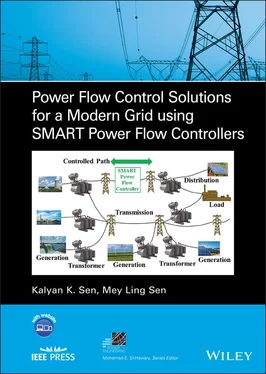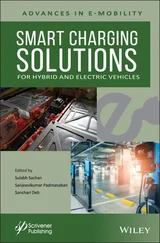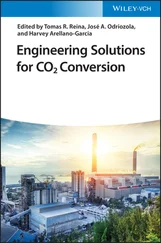Kalyan K. Sen - Power Flow Control Solutions for a Modern Grid Using SMART Power Flow Controllers
Здесь есть возможность читать онлайн «Kalyan K. Sen - Power Flow Control Solutions for a Modern Grid Using SMART Power Flow Controllers» — ознакомительный отрывок электронной книги совершенно бесплатно, а после прочтения отрывка купить полную версию. В некоторых случаях можно слушать аудио, скачать через торрент в формате fb2 и присутствует краткое содержание. Жанр: unrecognised, на английском языке. Описание произведения, (предисловие) а так же отзывы посетителей доступны на портале библиотеки ЛибКат.
- Название:Power Flow Control Solutions for a Modern Grid Using SMART Power Flow Controllers
- Автор:
- Жанр:
- Год:неизвестен
- ISBN:нет данных
- Рейтинг книги:5 / 5. Голосов: 1
-
Избранное:Добавить в избранное
- Отзывы:
-
Ваша оценка:
- 100
- 1
- 2
- 3
- 4
- 5
Power Flow Control Solutions for a Modern Grid Using SMART Power Flow Controllers: краткое содержание, описание и аннотация
Предлагаем к чтению аннотацию, описание, краткое содержание или предисловие (зависит от того, что написал сам автор книги «Power Flow Control Solutions for a Modern Grid Using SMART Power Flow Controllers»). Если вы не нашли необходимую информацию о книге — напишите в комментариях, мы постараемся отыскать её.
Power Flow Control Solutions for a Modern Grid using SMART Power Flow Controllers
Power Flow Control Solutions for a Modern Grid using SMART Power Flow Controllers
Power Flow Control Solutions for a Modern Grid Using SMART Power Flow Controllers — читать онлайн ознакомительный отрывок
Ниже представлен текст книги, разбитый по страницам. Система сохранения места последней прочитанной страницы, позволяет с удобством читать онлайн бесплатно книгу «Power Flow Control Solutions for a Modern Grid Using SMART Power Flow Controllers», без необходимости каждый раз заново искать на чём Вы остановились. Поставьте закладку, и сможете в любой момент перейти на страницу, на которой закончили чтение.
Интервал:
Закладка:
3 Chapter 3Table 3‐1 Electrical system data.Table 3‐2 Electrical system data.Table 3‐3 Electrical system data.Table 3‐4 Sending‐end voltage, power flows at the receiving end, and the exc...Table 3‐5 Effects of the variation of series‐compensating voltage on the pow...
4 Chapter 4Table 4‐1 Electrical system data.Table 4-2 Effects of the variation of series‐compensating voltage ( V s′ s...Table 4‐3 Effects of the variation of series‐compensating voltage ( V s′s...Table 4‐4 Electrical system data.Table 4‐5 Electrical system data.Table 4‐6 Effects of the variation of series‐compensating voltage ( V s′s...Table 4‐7 Electrical system data.Table 4‐8 Effects of the variation of shunt‐compensating voltage ( V s′)...Table 4‐9 Electrical system data.Table 4‐10 Effects of the variation of series‐compensating voltage ( V s′s...Table 4‐11 Electrical system data.Table 4‐12 Effects of the variation of series‐compensating voltage ( V s′s...Table 4‐13 Electrical system data.Table 4‐14 Effects of the variation of series‐compensating voltage ( V s′s...
5 Chapter 5Table 5‐1 Electrical system data.Table 5‐2 Electrical system data.Table 5‐3 Electrical system data.Table 5‐4 Electrical system data.Table 5‐5 Electrical system data.Table 5‐6 Electrical system data.
6 Chapter 6Table 2‐1 Electrical system data.Table 6‐1 Active turns‐ratios of the secondary, series‐compensating windings in t...Table 6‐2 Active turns‐ratios of the secondary, series‐compensating windings in t...Table 6‐3 Active turns‐ratios of the secondary, series‐compensating windings in t...Table 6‐4 Compensating voltage, modified sending‐end voltage, power flows at the ...Table 3‐2 Electrical system data.Table 6‐5 Compensating voltage, modified sending‐end voltage, power flows at the ...Table 6‐6 Electrical system data.Table 6‐7 Compensating voltage, modified sending‐end voltage, power flows at the ...Table 6‐8 Electrical system data.Table 6‐9 Compensating voltage, modified sending‐end voltage, power flows at the ...Table 6‐10 Electrical system data.Table 6‐11 Compensating voltage, modified sending‐end voltage, power flows a...Table 6‐12 Compensating voltage, modified sending‐end voltage, power flows at the...Table 6‐13 Components of Option 1 compensating voltages in the A, B, and C p...Table 6‐14 Components of Option 2 compensating voltages in the A, B, and C p...Table 6‐15 The compensating voltages in Option 3 for all phases.Table 6‐16 Comparison among the voltage‐regulating transformer (VRT), phase angle...
7 Appendix BTable B‐1 Line current for a VR and a PAR (asym).
8 Appendix CTable C‐1 Chilean grid simulation results.Table C‐2 Chilean contingency scenario results.
List of Illustrations
1 Chapter 1 Figure 1‐1 Part of a large interconnected transmission system supplying elec... Figure 1‐2 Power flow along a controlled path. Figure 1‐3 Representation of a transmission line between sending and receivi... Figure 1‐4 Power flow along a transmission line between sending and receivin... Figure 1‐5 (a) Electric grid: power flow along a lossless transmission line ... Figure 1‐6 Power flow in a lossless line with a series‐compensating reactanc... Figure 1‐7 Power flow in a lossless line with a series‐compensating voltage ... Figure 1‐8 (a) Power transmission system with a series‐compensating voltage ... Figure 1‐9 Transmission line Voltage Regulators: (a) Two‐winding Transformer... Figure 1‐10 Transmission line voltage Phase Angle Regulators: (a) asymmetric... Figure 1‐11 Transmission line Reactance Regulators: (a) Thyristor‐Controlled... Figure 1‐12 Ranges of voltages (V sand V s′) at the primary and seconda... Figure 1‐13 Response time of the first commercial STATCON for 100 Mvar capac... Figure 1‐14 Voltage profile without an SVC (left) and with an SVC (right) (f... Figure 1‐15 A single‐line diagram of an electric arc furnace. Figure 1‐16 Instantaneous plant input bus voltage ( v plant) and plant current... Figure 1‐17 Use of a STATCOM, combined with a Fixed Capacitor (FC) as an arc... Figure 1‐18 Instantaneous reactive power drawn by the furnace and supplied b... Figure 1‐19 Instantaneous active power drawn by a compensator (STATCOM and F... Figure 1‐20 Flicker measurements without and with a compensation provided by... Figure 1‐21 Single‐line diagram of a Dynamic Voltage Restorer (DVR). Figure 1‐22 Sag correction by a DVR (field performance) (Sen 2015). Figure 1‐23 (a) Basic circuits for Active Power Line Conditioner and (b) Uni... Figure 1‐24 Cost versus features in various solutions (Case 1: “do nothing;”... Figure 1‐25 World’s first UPFC at the AEP Inez substation (left) versus a co... Figure 1‐26 Point‐to‐point transfer of power with local reactive power compe... Figure 1‐27 Ranges of Q rversus P rat the receiving end of the transmission ... Figure 1‐28 Independent active and reactive power flow controller with local... Figure 1‐29 Independent power flow control by impedance regulation (field pe... Figure 1‐30 Simultaneous power flow control by reactance regulation (field p... Figure 1‐31 Sen Transformer (ST). Figure 1‐32 Autotransformer/PAR (asym). Figure 1‐33 Multiline power flow concepts. Figure 1‐34 Choices for transmission line control equipment. Figure 1‐35 Today’s grid with traditional generation and integrated renewabl... Figure 1‐36 Interconnected transmission system, integrated with a SMART Powe... Figure 1‐37 Voltage regulation with an SVC and independent power flow regula...
2 Chapter 2 Figure 2‐1 Representation of a power system network, consisting of a voltage... Figure 2‐2 (a) One‐generator/one‐line power system network and (b) phasor di... Figure 2‐3 Variations of load voltage ( V r) and load power ( P r) as a function... Figure 2‐4 (a) One‐generator/one‐line power system network with a shunt volt... Figure 2‐5 Variations of load voltage ( V r) and load power ( P r) as a function... Figure 2‐6 Two‐generator/one‐line power system network and the related phaso... Figure 2‐7 Two‐generator/one‐line power system network and the related phaso... Figure 2‐8 Voltage profile along a line when  pu and
pu and  . Figure 2‐9 Two methods of controlling the line voltage: (a) with a shunt‐com... Figure 2‐10 Scheme for implementing a shunt‐compensating voltage. Figure 2‐11 Scheme for implementing a series‐compensating voltage. Figure 2‐12 Electrical machine‐based solutions for power flow controllers us... Figure 2‐13 VSC‐based solutions for power flow controllers using (a) Shunt–S... Figure 2‐14 Transformer/LTCs‐based solutions for power flow controllers usin...Figure 2‐15 Q s′and V s′versus P s′at the modified sending...Figure 2‐16 Q rversus P rat the receiving end of the line for voltage regula...Figure 2‐17 (a) Power transmission system with a series‐compensating voltage...Figure 2‐18 Variations of the magnitude ( V s′) and phase‐shift angle ( ψ ...Figure 2‐19 (a) Two‐generator/one‐line power system network and its series‐c...Figure 2‐20 (a) Two‐generator/one‐line power system network and its series‐c...Figure 2‐21 (a) Variation of the sending‐end active and reactive power flows...Figure 2‐22 (a) Variation of the receiving‐end active and reactive power flo...Figure 2‐23 (a) Variation of the modified sending‐end active and reactive po...Figure 2‐24 (a) Power transmission system with a series‐compensating voltage...Figure 2‐25 (a) Variation of the exchanged active and reactive powers ( P sea...Figure 2‐26 (a) Two‐generator/one‐line power system network and its series‐c...Figure 2‐27 Phasor diagram of a PAR (sym): (a) active power flow,
. Figure 2‐9 Two methods of controlling the line voltage: (a) with a shunt‐com... Figure 2‐10 Scheme for implementing a shunt‐compensating voltage. Figure 2‐11 Scheme for implementing a series‐compensating voltage. Figure 2‐12 Electrical machine‐based solutions for power flow controllers us... Figure 2‐13 VSC‐based solutions for power flow controllers using (a) Shunt–S... Figure 2‐14 Transformer/LTCs‐based solutions for power flow controllers usin...Figure 2‐15 Q s′and V s′versus P s′at the modified sending...Figure 2‐16 Q rversus P rat the receiving end of the line for voltage regula...Figure 2‐17 (a) Power transmission system with a series‐compensating voltage...Figure 2‐18 Variations of the magnitude ( V s′) and phase‐shift angle ( ψ ...Figure 2‐19 (a) Two‐generator/one‐line power system network and its series‐c...Figure 2‐20 (a) Two‐generator/one‐line power system network and its series‐c...Figure 2‐21 (a) Variation of the sending‐end active and reactive power flows...Figure 2‐22 (a) Variation of the receiving‐end active and reactive power flo...Figure 2‐23 (a) Variation of the modified sending‐end active and reactive po...Figure 2‐24 (a) Power transmission system with a series‐compensating voltage...Figure 2‐25 (a) Variation of the exchanged active and reactive powers ( P sea...Figure 2‐26 (a) Two‐generator/one‐line power system network and its series‐c...Figure 2‐27 Phasor diagram of a PAR (sym): (a) active power flow,  pu; (b) ...Figure 2‐28 RR operating with a reactance control method: (a) two‐generator/...Figure 2‐29 Series‐reactance regulation as combined effects voltage regulati...Figure 2‐30 RR operating with a reactance control method: (a) two‐generator/...Figure 2‐31 Effect of a compensating reactance on the power flow and the eff...Figure 2‐32 RR operating with a reactance control method: (a) two‐generator/...Figure 2‐33 RR operating with a reactance control method: (a) two‐generator/...Figure 2‐34 Effect of a compensating reactance on the power flow and the eff...Figure 2‐35 RR operating with a voltage control method with a compensating v...Figure 2‐36 RR operating with a voltage control method when a compensating v...Figure 2‐37 Effect of compensating voltage on power flow, effective line rea...Figure 2‐38 Power flow characteristics at the modified sending end and recei...Figure 2‐39 Variations of series‐compensating resistance and reactance of an...Figure 2‐40 Variations of series‐compensating impedance magnitude and its ph...Figure 2‐41 Variations of series‐compensating resistance and reactance of a ...Figure 2‐42 Variations of series‐compensating impedance magnitude and its ph...Figure 2‐43 Variations of series‐compensating resistance and reactance of a ...Figure 2‐44 Variations of series‐compensating impedance magnitude and its ph...Figure 2‐45 Variations of series‐compensating resistance and reactance of a ...Figure 2‐46 Variations of series‐compensating impedance magnitude and its ph...Figure 2‐47 Variations of series‐compensating resistance and reactance of a ...Figure 2‐48 Variations of series‐compensating impedance magnitude and its ph...Figure 2‐49 (a) Autotransformer. (b) Two‐winding transformer. (c) Ratio of t...Figure 2‐50 Q rvs P rat the receiving end of the line for the range of modif...Figure 2‐51 (a) Voltage‐Regulating Transformer (Shunt–Series configuration);...Figure 2‐52 Thyristor‐Controlled Load Tap Changer.Figure 2‐53 Static Var Compensator (SVC).Figure 2‐54 Concept of a STATCOM.Figure 2‐55 Static synchronous compensator (STATCOM).Figure 2‐56 Two‐generator/one‐line power system network with (a) no compensa...Figure 2‐57 Two‐generator/one‐line power system network with (a) no compensa...Figure 2‐58 (a) Phase Angle Regulator (asym), (b) phasor diagram for decreas...Figure 2‐59 (a) Phase Angle Regulator (sym), (b) phasor diagram for decreasi...Figure 2‐60 Thyristor‐Controlled Series Capacitor (TCSC) ( k is the number of...Figure 2‐61 Static Synchronous Series Compensator (SSSC).Figure 2‐62 The UPFC (with a common DC link) and its building blocks: STATCO...Figure 2‐63 Two‐generator/one‐line power system network, integrated with a P...Figure 2‐64 Unified Power Flow Controller (UPFC).Figure 2‐65 Basic UPFC model, integrated in a two‐generator/one‐line power s...Figure 2‐66 Sen Transformer (ST).Figure 2‐67 Basic ST model, integrated in a two‐generator/one‐line power sys...Figure 2‐68 Basic BTB‐SSSC, integrated in a three‐generator/two‐line power s...Figure 2‐69 Implementation of a basic BTB‐SSSC.Figure 2‐70 BTB‐SSSC scheme as an asynchronous tie, integrated in a four‐gen...Figure 2‐71 Basic MST, integrated in a three‐generator/two‐line power system...Figure 2‐72 Multiline Sen transformer (MST).Figure 2‐73 Back‐To‐Back STATCOM (BTB‐STATCOM), integrated in a two‐generato...Figure 2‐74 Back‐to‐Back STATCOM.Figure 2‐75 Generalized power flow controller with a DC link.Figure 2‐76 Generalized power flow controller with an AC link.Figure 2‐77 Phasor diagram of VR for (a) no power flow, (b) 100% power flow ...Figure 2‐78 (a) Phasor diagram of a two‐generator/one‐line power system netw...Figure 2‐79 (a) Phasor diagram of a two‐generator/one‐line power system netw...Figure 2‐80 (a) Phasor diagram of a two‐generator/one‐line power system netw...Figure 2‐81 (a) Phasor diagram of a two‐generator/one‐line power system netw...Figure 2‐82 (a) Phasor diagram of a two‐generator/one‐line power system netw...Figure 2‐83 (a) Phasor diagram of a two‐generator/one‐line power system netw...Figure 2‐84 (a) Phasor diagram of a two‐generator/one‐line power system netw...Figure 2‐85 (a) Phasor diagram of a two‐generator/one‐line power system netw...Figure 2‐86 (a) Phasor diagram of a two‐generator/one‐line power system netw...Figure 2‐87 (a) Phasor diagram of a two‐generator/one‐line power system netw...Figure 2‐88 (a) Phasor diagram of a two‐generator/one‐line power system netw...Figure 2‐89 (a) Phasor diagram of a two‐generator/one‐line power system netw...Figure 2‐90 Phasor diagram of a PAR (sym) for (a) no power flow, (b) 100% po...Figure 2‐91 Phasor diagram of PAR (asym) for (a) no power flow, (b) 100% pow...Figure 2‐92 Phasor diagram of a RR for (a) no power flow, (b) 100% power flo...Figure 2‐93 Phasor diagram of an IR for (a) no power flow, (b) 100% power fl...Figure 2‐94 Voltage magnitude at the modified sending end for the range of a...Figure 2‐95 Power flow characteristics at the modified sending end for the r...Figure 2‐96 Power flow characteristics at the receiving end for the range of...Figure 2‐97 Reactive Power Index ( RPI ) versus active power ( P r) flow at the ...Figure 2‐98 Loss Index ( LI ) versus active power ( P r) flow at the receiving e...Figure 2‐99 Apparent Power Rating ( APR ) versus active power ( P r) flow at the...Figure 2‐100 Two‐generator/one‐line power system network without any compens...Figure 2‐101 Two‐generator/one‐line power system network with shunt compensa...Figure 2‐102 Two‐generator/one‐line power system network with two shunt comp...Figure 2‐103 Two‐generator/one‐line power system network with three shunt co...Figure 2‐104 Active power at the sending and receiving ends versus number of...Figure 2‐105 RPI versus number of shunt compensators.Figure 2‐106 LI versus number of compensators.Figure 2‐107 Total APR of shunt compensation versus number of shunt compensa...Figure 2‐108 Series‐compensating reactance versus equivalent shunt compensat...Figure 2‐109 RPI of series compensation versus equivalent shunt compensation...Figure 2‐110 LI of series compensation versus equivalent shunt compensation ...Figure 2‐111 APR of series compensation versus equivalent shunt compensation...Figure 2‐112 Two‐generator/one‐line power system network with a lossy line a...Figure 2‐113 Two‐generator/one‐line power system network with a lossy line a...Figure 2‐114 Reactive Power Index ( RPI ) versus active power flow ( P r) at the...Figure 2‐115 Loss Index ( LI ) versus active power flow ( P r) at the receiving ...Figure 2‐116 Apparent Power Rating ( APR ) versus active power flow ( P r) at th...Figure 2‐117 Sen Index (SI) versus active power flow ( P r) at the receiving e...
pu; (b) ...Figure 2‐28 RR operating with a reactance control method: (a) two‐generator/...Figure 2‐29 Series‐reactance regulation as combined effects voltage regulati...Figure 2‐30 RR operating with a reactance control method: (a) two‐generator/...Figure 2‐31 Effect of a compensating reactance on the power flow and the eff...Figure 2‐32 RR operating with a reactance control method: (a) two‐generator/...Figure 2‐33 RR operating with a reactance control method: (a) two‐generator/...Figure 2‐34 Effect of a compensating reactance on the power flow and the eff...Figure 2‐35 RR operating with a voltage control method with a compensating v...Figure 2‐36 RR operating with a voltage control method when a compensating v...Figure 2‐37 Effect of compensating voltage on power flow, effective line rea...Figure 2‐38 Power flow characteristics at the modified sending end and recei...Figure 2‐39 Variations of series‐compensating resistance and reactance of an...Figure 2‐40 Variations of series‐compensating impedance magnitude and its ph...Figure 2‐41 Variations of series‐compensating resistance and reactance of a ...Figure 2‐42 Variations of series‐compensating impedance magnitude and its ph...Figure 2‐43 Variations of series‐compensating resistance and reactance of a ...Figure 2‐44 Variations of series‐compensating impedance magnitude and its ph...Figure 2‐45 Variations of series‐compensating resistance and reactance of a ...Figure 2‐46 Variations of series‐compensating impedance magnitude and its ph...Figure 2‐47 Variations of series‐compensating resistance and reactance of a ...Figure 2‐48 Variations of series‐compensating impedance magnitude and its ph...Figure 2‐49 (a) Autotransformer. (b) Two‐winding transformer. (c) Ratio of t...Figure 2‐50 Q rvs P rat the receiving end of the line for the range of modif...Figure 2‐51 (a) Voltage‐Regulating Transformer (Shunt–Series configuration);...Figure 2‐52 Thyristor‐Controlled Load Tap Changer.Figure 2‐53 Static Var Compensator (SVC).Figure 2‐54 Concept of a STATCOM.Figure 2‐55 Static synchronous compensator (STATCOM).Figure 2‐56 Two‐generator/one‐line power system network with (a) no compensa...Figure 2‐57 Two‐generator/one‐line power system network with (a) no compensa...Figure 2‐58 (a) Phase Angle Regulator (asym), (b) phasor diagram for decreas...Figure 2‐59 (a) Phase Angle Regulator (sym), (b) phasor diagram for decreasi...Figure 2‐60 Thyristor‐Controlled Series Capacitor (TCSC) ( k is the number of...Figure 2‐61 Static Synchronous Series Compensator (SSSC).Figure 2‐62 The UPFC (with a common DC link) and its building blocks: STATCO...Figure 2‐63 Two‐generator/one‐line power system network, integrated with a P...Figure 2‐64 Unified Power Flow Controller (UPFC).Figure 2‐65 Basic UPFC model, integrated in a two‐generator/one‐line power s...Figure 2‐66 Sen Transformer (ST).Figure 2‐67 Basic ST model, integrated in a two‐generator/one‐line power sys...Figure 2‐68 Basic BTB‐SSSC, integrated in a three‐generator/two‐line power s...Figure 2‐69 Implementation of a basic BTB‐SSSC.Figure 2‐70 BTB‐SSSC scheme as an asynchronous tie, integrated in a four‐gen...Figure 2‐71 Basic MST, integrated in a three‐generator/two‐line power system...Figure 2‐72 Multiline Sen transformer (MST).Figure 2‐73 Back‐To‐Back STATCOM (BTB‐STATCOM), integrated in a two‐generato...Figure 2‐74 Back‐to‐Back STATCOM.Figure 2‐75 Generalized power flow controller with a DC link.Figure 2‐76 Generalized power flow controller with an AC link.Figure 2‐77 Phasor diagram of VR for (a) no power flow, (b) 100% power flow ...Figure 2‐78 (a) Phasor diagram of a two‐generator/one‐line power system netw...Figure 2‐79 (a) Phasor diagram of a two‐generator/one‐line power system netw...Figure 2‐80 (a) Phasor diagram of a two‐generator/one‐line power system netw...Figure 2‐81 (a) Phasor diagram of a two‐generator/one‐line power system netw...Figure 2‐82 (a) Phasor diagram of a two‐generator/one‐line power system netw...Figure 2‐83 (a) Phasor diagram of a two‐generator/one‐line power system netw...Figure 2‐84 (a) Phasor diagram of a two‐generator/one‐line power system netw...Figure 2‐85 (a) Phasor diagram of a two‐generator/one‐line power system netw...Figure 2‐86 (a) Phasor diagram of a two‐generator/one‐line power system netw...Figure 2‐87 (a) Phasor diagram of a two‐generator/one‐line power system netw...Figure 2‐88 (a) Phasor diagram of a two‐generator/one‐line power system netw...Figure 2‐89 (a) Phasor diagram of a two‐generator/one‐line power system netw...Figure 2‐90 Phasor diagram of a PAR (sym) for (a) no power flow, (b) 100% po...Figure 2‐91 Phasor diagram of PAR (asym) for (a) no power flow, (b) 100% pow...Figure 2‐92 Phasor diagram of a RR for (a) no power flow, (b) 100% power flo...Figure 2‐93 Phasor diagram of an IR for (a) no power flow, (b) 100% power fl...Figure 2‐94 Voltage magnitude at the modified sending end for the range of a...Figure 2‐95 Power flow characteristics at the modified sending end for the r...Figure 2‐96 Power flow characteristics at the receiving end for the range of...Figure 2‐97 Reactive Power Index ( RPI ) versus active power ( P r) flow at the ...Figure 2‐98 Loss Index ( LI ) versus active power ( P r) flow at the receiving e...Figure 2‐99 Apparent Power Rating ( APR ) versus active power ( P r) flow at the...Figure 2‐100 Two‐generator/one‐line power system network without any compens...Figure 2‐101 Two‐generator/one‐line power system network with shunt compensa...Figure 2‐102 Two‐generator/one‐line power system network with two shunt comp...Figure 2‐103 Two‐generator/one‐line power system network with three shunt co...Figure 2‐104 Active power at the sending and receiving ends versus number of...Figure 2‐105 RPI versus number of shunt compensators.Figure 2‐106 LI versus number of compensators.Figure 2‐107 Total APR of shunt compensation versus number of shunt compensa...Figure 2‐108 Series‐compensating reactance versus equivalent shunt compensat...Figure 2‐109 RPI of series compensation versus equivalent shunt compensation...Figure 2‐110 LI of series compensation versus equivalent shunt compensation ...Figure 2‐111 APR of series compensation versus equivalent shunt compensation...Figure 2‐112 Two‐generator/one‐line power system network with a lossy line a...Figure 2‐113 Two‐generator/one‐line power system network with a lossy line a...Figure 2‐114 Reactive Power Index ( RPI ) versus active power flow ( P r) at the...Figure 2‐115 Loss Index ( LI ) versus active power flow ( P r) at the receiving ...Figure 2‐116 Apparent Power Rating ( APR ) versus active power flow ( P r) at th...Figure 2‐117 Sen Index (SI) versus active power flow ( P r) at the receiving e...
Интервал:
Закладка:
Похожие книги на «Power Flow Control Solutions for a Modern Grid Using SMART Power Flow Controllers»
Представляем Вашему вниманию похожие книги на «Power Flow Control Solutions for a Modern Grid Using SMART Power Flow Controllers» списком для выбора. Мы отобрали схожую по названию и смыслу литературу в надежде предоставить читателям больше вариантов отыскать новые, интересные, ещё непрочитанные произведения.
Обсуждение, отзывы о книге «Power Flow Control Solutions for a Modern Grid Using SMART Power Flow Controllers» и просто собственные мнения читателей. Оставьте ваши комментарии, напишите, что Вы думаете о произведении, его смысле или главных героях. Укажите что конкретно понравилось, а что нет, и почему Вы так считаете.












